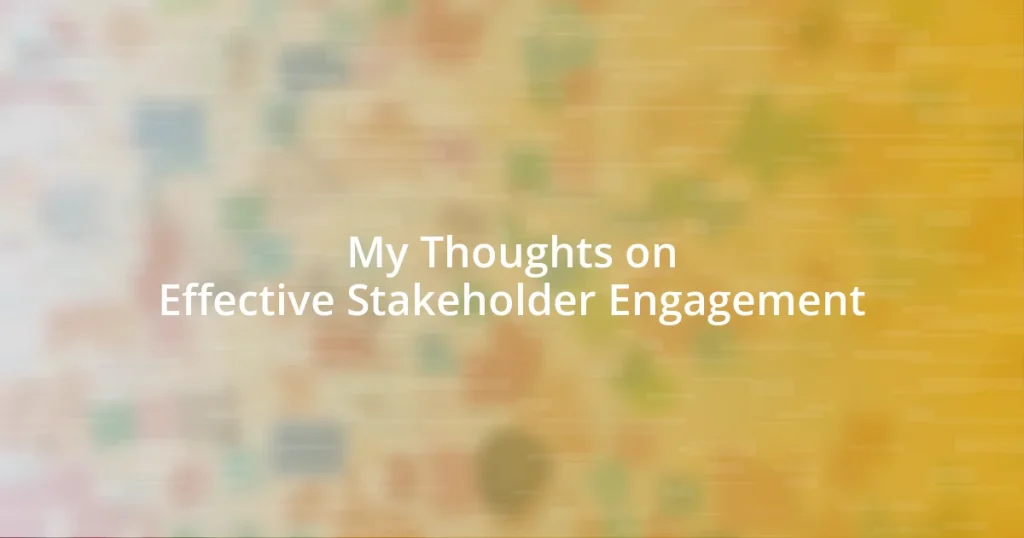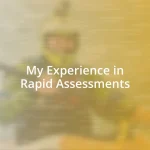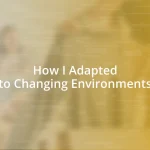Key takeaways:
- Effective stakeholder engagement builds trust and transparency, leading to better collaboration and long-term relationships.
- Identifying and prioritizing stakeholders based on their influence and interests is essential for gathering valuable insights and ensuring project success.
- Continuous improvement of engagement processes through regular feedback and open communication fosters accountability and empowers stakeholders to contribute meaningfully.

Understanding Stakeholder Engagement Importance
Effective stakeholder engagement is crucial because it lays the foundation for successful collaboration. I once worked on a project where stakeholder input reshaped our initial ideas, leading to a more robust outcome. If we overlook the voices of those invested in our work, how can we expect to meet their needs?
When you genuinely engage stakeholders, you foster trust and transparency. I remember when a client expressed frustration over feeling left out of decision-making. Opening up channels for their feedback not only resolved the tension but also built a stronger partnership. Isn’t it incredible how just a little attention can turn potential conflict into a shared vision?
Moreover, understanding the importance of stakeholder engagement enhances long-term sustainability. In a previous role, we initiated regular check-ins with our stakeholders, resulting in ongoing support even after project completion. This made me realize: what’s the point of working hard if we can’t maintain those precious relationships? Building rapport isn’t just about immediate wins; it’s about laying the groundwork for future success.

Identifying Key Stakeholders Effectively
Identifying key stakeholders effectively requires a thoughtful approach. I recall a time when I conducted a stakeholder mapping exercise for a community initiative. By categorizing individuals based on their influence and interest, I was able to pinpoint not just the obvious stakeholders, but also those who might have flown under the radar. This discovery taught me the importance of considering varied perspectives, as sometimes, those less vocal hold the keys to significant insights.
Another vital aspect is prioritizing stakeholders based on their level of impact on the project. In my experience, I once met with a minor community leader who felt overlooked. After listening to their concerns, we adjusted our plans, which ultimately led to greater community support. This demonstrated to me that even those in seemingly small roles can wield considerable influence, especially when it comes to grassroots sentiments.
Lastly, I find that using technology can enhance stakeholder identification efforts. By utilizing digital tools like surveys and social media analytics, I can gather valuable data on interests and opinions. I remember analyzing feedback from an online poll. The results not only highlighted key players but also provided insight into the values that mattered most to them. Engaging stakeholders takes time and effort, but the clarity gained from effective identification can set the stage for so much more.
| Stakeholder Type | Importance Level |
|---|---|
| High Influence, High Interest | Crucial to project success, require regular updates and engagement |
| High Influence, Low Interest | Keep satisfied but not overwhelmed with information |
| Low Influence, High Interest | Engage to gather insights, regular communication is essential |
| Low Influence, Low Interest | Monitor, minimal effort needed unless their stance changes |

Building Trust and Rapport
Building trust and rapport is essential for effective stakeholder engagement. I can’t stress enough how much this becomes the backbone of any collaborative effort. Once, during a particularly challenging project, I took the time to share not just updates but my own struggles and contexts with stakeholders. The result? They opened up about their challenges too, and our relationship shifted from mere transactions to genuine collaboration. I’ve learned that transparency and vulnerability can create a solid foundation that nurtures trust.
To cultivate trust and rapport effectively, consider these strategies:
- Active Listening: Make it a point to listen more than you speak. Stakeholders often need to feel heard.
- Be Honest: Share both good and bad news. Authenticity resonates more than sugar-coated updates.
- Follow Through: If you commit to actions based on feedback, ensure you deliver. Reliability builds trust.
- Personalize Interactions: Taking the time to understand individual stakeholder backgrounds helps foster deeper connections.
- Celebrate Milestones Together: I recall organizing a small celebration for our stakeholders when we hit a project milestone. It transformed our relationship, making them feel valued and part of our success.
Each of these steps requires a genuine commitment, but the rewards in terms of trust and collaboration are invaluable.

Effective Communication Strategies
Effective communication strategies can significantly enhance stakeholder engagement. One approach that I’ve always found useful is tailoring communication styles to fit different stakeholder preferences. For instance, I once worked with a group where some members thrived on detailed reports while others preferred concise email updates. That taught me the value of flexibility—by providing the right information in the right format, I not only kept everyone informed but also maintained their interest and engagement.
Another strategy involves establishing regular check-ins, which I’ve found to be a game-changer. In a recent project, we scheduled bi-weekly catch-ups with stakeholders, and that openness led to richer discussions. I remember when a stakeholder shared a crucial concern that, if left unaddressed, could have derailed our project. By fostering an open dialogue, we avoided potential pitfalls and came up with quicker solutions together. Isn’t it amazing how a simple conversation can shift the course of a project?
Moreover, using storytelling in communication can have a profound impact. I often framed project updates within personal stories, drawing parallels to everyday experiences that stakeholders could relate to. This approach not only made the information more digestible but also connected emotionally with the audience. I recall sharing a story about a community project that faced initial resistance but ultimately resulted in local pride and ownership. That connection sparked enthusiasm, fostering a sense of collective purpose. Wouldn’t it be great to engage stakeholders in a way that moves them to action?

Engaging Stakeholders in Decision Making
Engaging stakeholders in decision-making is not merely about gathering opinions; it’s about creating a genuine partnership. I remember an instance when we faced a significant decision that could impact the entire project outcome. I invited key stakeholders into a brainstorming session, where we laid out all the options together. Their insights changed my perspective entirely, highlighting angles I hadn’t considered. That cooperative approach made everyone feel included and empowered, turning a potentially contentious issue into an opportunity for shared ownership.
One key element I’ve found effective in this process is validating stakeholder input. When stakeholders see their ideas reflected in decisions, they feel valued and more invested in the outcome. I once facilitated a workshop where we combed through stakeholders’ suggestions meticulously. At the end, we outlined how their contributions shaped our final strategy. The energy in the room was palpable; everyone felt their voices mattered. Have you ever witnessed how quickly engagement shifts when people know their opinions are being taken seriously?
Creating a culture of collaboration requires openness and a willingness to adapt. In a previous project, we integrated feedback loops that allowed stakeholders to voice their thoughts at various stages. When one stakeholder expressed concern about our timeline, it inspired a pivotal change that ultimately streamlined our efforts. I’ve learned that when stakeholders feel their voices truly resonate in decision-making, the projects not only benefit from diverse insights but also foster a sense of accountability and enthusiasm. It’s invigorating to watch that collective momentum build!

Measuring Stakeholder Engagement Success
Measuring the success of stakeholder engagement is crucial for continuous improvement. I often reflect on the outcomes of my projects using both qualitative and quantitative metrics. For example, after finishing a project, I distribute surveys to stakeholders to gather their feedback. The responses help me gauge their satisfaction and highlight areas where I might improve. It’s fascinating to see how much clarity can come from just asking the right questions.
I also remember a time when we employed a stakeholder engagement scorecard. This tool tracked participation rates, feedback quality, and overall sentiment. Looking back, the data revealed not just the engagement levels but also where relationships needed nurturing. Have you ever noticed how some stakeholders are more engaged than others? Identifying these patterns allows me to strategize different approaches, creating tailored experiences that truly resonate with each group’s needs.
Finally, I take the time to analyze the long-term impacts of engagement efforts. In a previous project, I revisited stakeholder relationships several months after project completion. Many stakeholders expressed how their involvement had changed their perception of the organization positively. It made me realize that success isn’t just about immediate project outcomes; it’s about building trust and ensuring that stakeholders feel connected to our mission. Isn’t it incredible how rapport can lead to lasting partnerships?

Continuous Improvement in Engagement Processes
Continuous improvement in engagement processes requires a commitment to learning and adapting. I recall a project where our initial engagement strategy didn’t resonate. Rather than pushing forward, we took a step back and sought feedback from our stakeholders. Their honest reflections prompted us to pivot our approach, capturing their interests and concerns more effectively. Isn’t it refreshing when you realize that the path to improvement often lies in listening?
Another aspect I’ve witnessed is the power of regular check-ins during the engagement process. In one instance, my team and I initiated bi-monthly catch-up sessions with key stakeholders. These informal chats allowed us to discuss ongoing concerns and fostered a sense of transparency. I can’t stress enough how beneficial it was to hear firsthand what was working and what wasn’t. Have you ever felt the relief that comes from knowing stakeholders have a platform to express themselves openly?
Incorporating feedback mechanisms alongside the engagement process enhances accountability. I remember setting up a user-friendly online platform for stakeholders to submit their ideas and concerns anytime. The change was palpable; stakeholders became more proactive, sharing innovative solutions that I might have overlooked. When they know their contributions have a real impact, a newfound energy emerges. It’s remarkable how empowering engagement can drive collective progress forward!















